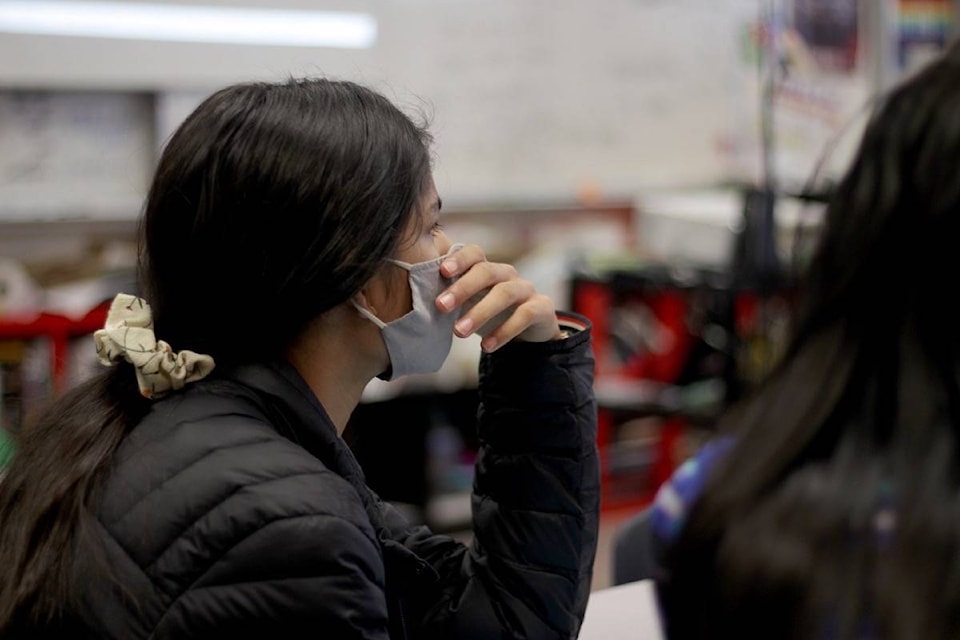The Surrey Teachers’ Association says it’s “not too late to make changes that can still save lives” following a leaked B.C. Centre for Disease Control report that showed the positivity rate in parts of Surrey was more than 20 per cent.
The documents, which were first obtained by the Vancouver Sun, showed the distribution of B.C. coronavirus cases broken down into local neighbourhoods, different from what has been released since the pandemic began early in 2020. The internal report was for the week of April 23 to 29, 2021.
READ ALSO: Surrey communities recording more COVID-19 cases also seeing lower vaccination rates, May 8, 2021
The B.C. CDC breaks Surrey into two sub-regions: Surrey (the northern part of the city) and South Surrey/White Rock. The city consists of nine communities: Cloverdale, East Newton, West Newton, Fleetwood, Guildford, North Surrey, Panorama and Whalley and South Surrey.
In the report, it showed that the positivity rate in most of Surrey was either between 5.1 to 10 per cent (Cloverdale, South Surrey) or 10.1 to 20 per cent (Panorama, Fleetwood, East Newton Guildford), but the northwest part of the city (Whalley, North Surrey and West Newton) had a positivity rate of more than 20 per cent.
According to a release from the BC Teachers’s Federation on behalf of the STA, it says that in that northwest quadrant, there are three secondary schools and 23 elementary schools.
During the week of April 23 to 29, those 26 schools had 105 exposure notifications and five elementary classes and 132 other individuals (staff and students) were sent into isolation. In comparison, the district as a whole had nine classes (mostly kindergarten to Grade 4) and 589 individuals sent into isolation.
That northwest quadrant accounts for about 22 per cent of all isolations that week.
Matt Westphal, president of the STA, said that when people see numbers like that, they may not understand what that looks like in classrooms and in schools, in the lives of teachers and students in that area.
“A teacher told me they can’t social distance in their Kindergarten class,” he said. “They have circular tables with no other option, so the kids face each other all day. The teacher tries to encourage students to wear masks, but don’t have a mandate to back them up. When kids get sick at school, their parents struggle to get them tested. Teachers send sick kids home weekly, and they often return without being tested because so many in the community can’t afford to take time off work.”
The STA is continuing to push for reduced class sizes, a mask mandate for kindergarten to Grade 3, remote learning options and improved ventilation in schools.
READ ALSO: ‘There can be more’: Surrey teachers push for better COVID safety measures, May 1, 2021
This comes as a report from Fraser Health on COVID-19 school cluster and transmission analysis was first posted on social media and then later released officially by the health authority.
The report, dated May 7, 2021, includes data on COVID-19 cases reported to public health between Jan. 1 and March 7, 2021 for both public and independent schools. It identifies schools with more than one case in a 14-day period, which could be a “confirmed cluster” of at least one person in a 14-day period or a “declared outbreak” of a cluster with evidence of ongoing transmission in multiple classrooms and admin areas.
Between Jan. 1 and March 7, 2021, there were 35 cluster or outbreak locations in the Surrey school district. That’s more than 20 per cent of the more than 130 schools in the district.
A key finding from the report states that 72.8 per cent of clusters throughout Fraser Health were brought into schools by students, adding “this was expected as students proportionately make up the majority of the school population.
By the end of April, Surrey had about 26 per cent of the overall cases, 33,146 in total, but only accounts for about 11 per cent of B.C.’s total population.
– With files from Ashley Wadhwani
lauren.collins@surreynowleader.com
Like us on Facebook Follow us on Instagram and follow Lauren on Twitter
